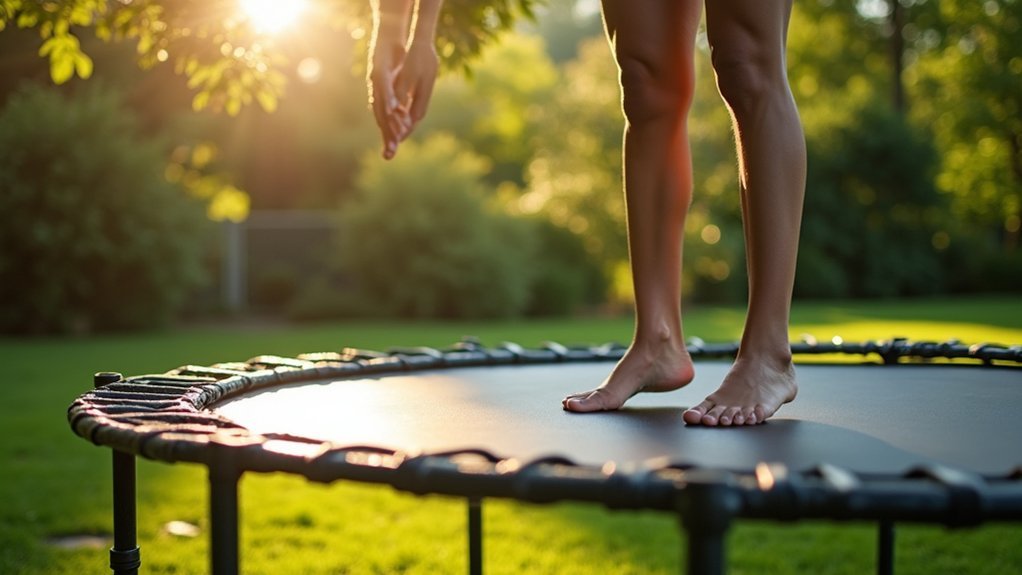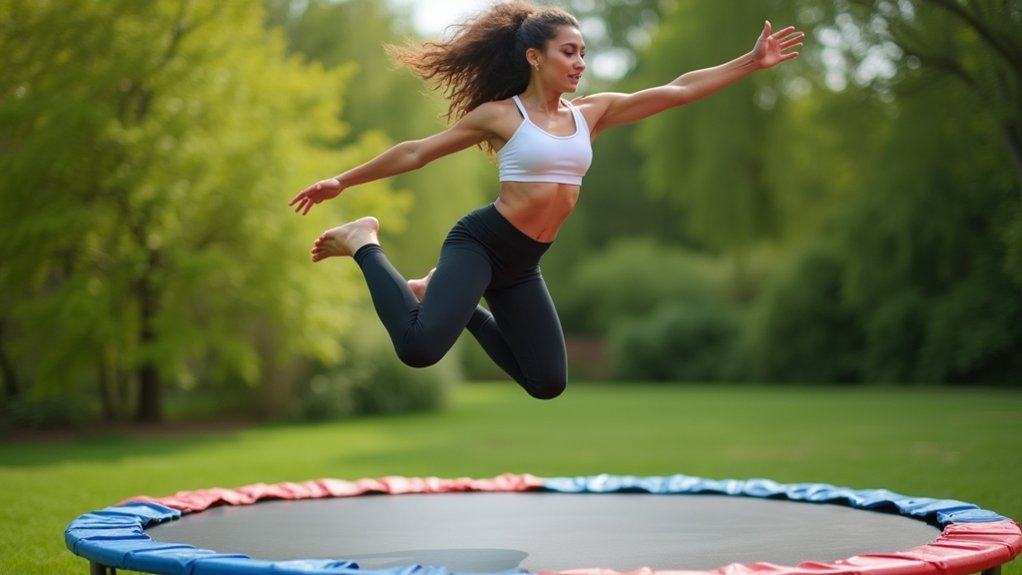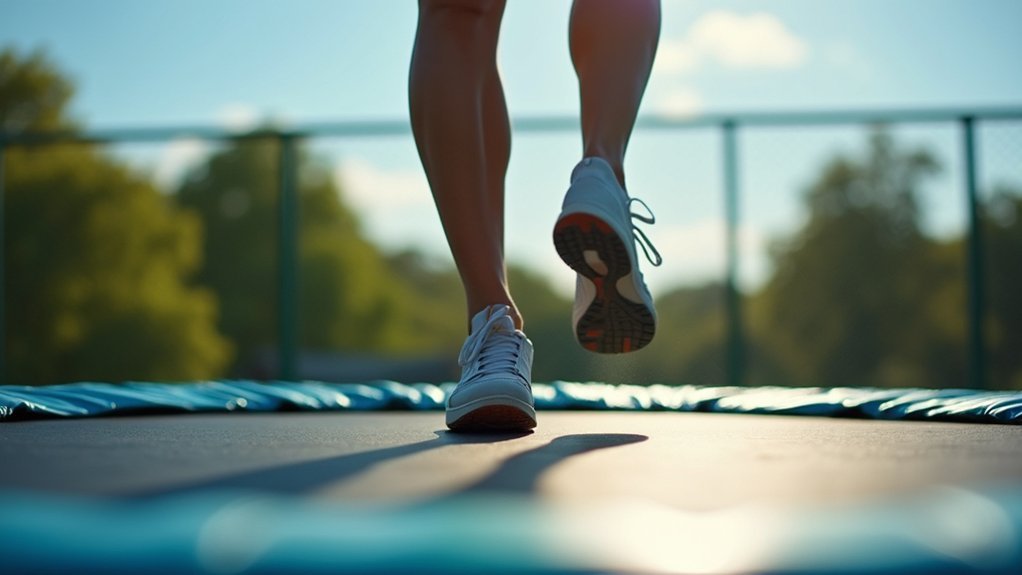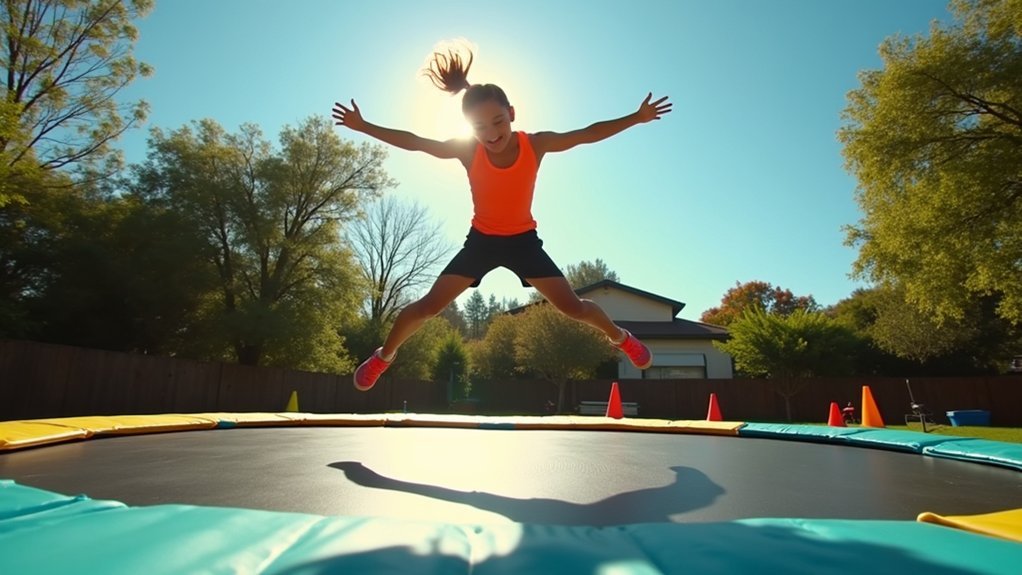You’ll strengthen balance on a trampoline by starting with stability training before attempting bounces. Master proper foot positioning with weight evenly distributed, and engage your core as your balance command center. Challenge yourself with single-leg exercises, then progress to dynamic movement patterns. Incorporate visual focus techniques by tracking fixed points while jumping. Add anti-rotation challenges as you advance. Measure your progress with regular assessments like timed single-leg stands to track your transformation.
Start With Structured Stability Before Bouncing

While many newcomers rush straight into bouncing, establishing foundational stability on the trampoline is essential for both safety and skill progression.
Begin with static stance training, positioning your feet hip-width apart to activate core and postural muscles. Fix your gaze on a stationary point while practicing controlled diaphragmatic breathing.
Gradually introduce weight shifting exercises, moving your body weight between feet without lifting them to enhance proprioception. This technique mimics the weight shift jumps that promote lymphatic fluid movement and improve balance. Maintain parallel foot positioning to prevent lateral instability. Use handlebars lightly at first, but avoid over-reliance on them.
Spend 2-3 weeks in this introductory phase before attempting bounces. Start with 30-second stability holds and progress to 90 seconds as you improve.
Remember to maintain a 1:2 work-to-rest ratio to allow proper neuromuscular recovery between drills.
Master the Feet-First Foundation for Better Balance
Balance on a trampoline begins with proper foot positioning as your foundational skill. Place your feet hip-width apart with slightly bent knees to lower your center of gravity.
Distribute weight evenly across both feet, focusing on the outside corners of your heels and the balls of your big and little toes for maximum stability.
Your foundation for trampoline stability lies in evenly distributed weight across your feet’s balance points—heel corners and toe bases.
When bouncing, lift your heels while keeping the balls of your feet pressed into the mat. This grounding technique keeps your body centered and balanced during movement. Focus on pushing feet down into the mat rather than trying to jump high for better control and stability.
You’ll need to adjust your stance based on your trampoline’s size and design.
- Start with small, controlled bounces to build muscle memory
- Practice rhythmic movements to synchronize your body naturally
- Engage your core muscles to stabilize your body during all exercises
Engage Your Core as Your Balance Command Center

Your core functions as the control tower for balance during trampoline workouts, requiring intentional activation throughout each movement.
Begin with micro-bounces while maintaining a hollow body position—drawing your navel toward your spine and slightly tucking your tailbone. These movements engage the transverse abdominis, which provides essential stability during dynamic exercises.
Challenge your stability further by adding anti-rotation elements like reaching arms in opposing directions while maintaining a centered bounce position.
Micro-Bounces for Stability
Achieving stability on a trampoline begins with mastering micro-bounces, where your core serves as the command center for balance. These gentle, controlled movements activate your abdominal muscles, creating a strong foundation that prevents wobbling and improves overall stability.
When performing micro-bounces, focus on:
- Maintaining proper posture with shoulders relaxed and spine aligned
- Engaging your core muscles throughout each bounce, not just at impact
- Allowing your legs to develop natural stiffness through controlled flexion
These low-impact movements are perfect for developing proprioception—your body’s spatial awareness—while reducing joint stress.
You’ll notice improved coordination as your nervous system adapts to the trampoline’s elastic surface. Start with just a few minutes daily to build confidence before progressing to more dynamic exercises. For optimal form, maintain a micro bend in knees and slightly hinge forward at the waist as you bounce.
Hollow Body Position
The hollow body position serves as the cornerstone of trampoline stability, transforming your entire physique into a controlled, unified structure. Master this position by pressing your lower back, glutes, and heels into the floor while lifting your shoulders and extending your limbs at 15-30° angles.
Maintain three critical elements: tucked chin with neutral neck alignment, fully extended limbs with locked elbows, and your navel drawn toward your spine. Don’t let your lower back arch—this common error undermines your stability. This focus on keeping the anterior chain engaged helps maximize core tension throughout the exercise.
Progress methodically from bent-knee holds to straight-leg variations before attempting hollow rocks.
Once you’ve achieved 30-second holds with proper form, practice micro-bounces on the trampoline. This progression develops the core strength necessary for efficient rebounds and controlled aerial movements.
Anti-Rotation Challenges
While mastering rebound control requires proper positioning, anti-rotation training develops your core’s ability to resist unwanted twisting forces during trampoline work. Your body’s natural tendency is to rotate during directional changes, but you’ll need stability to maintain control.
Add these challenges to your routine:
- Hold your arms in static positions during jumps to force your core to counteract rotational inertia instead of relying on arm momentum.
- Perform feet-tap jumps from different landing positions with head turns toward your axis side to strengthen neuromuscular control.
- Introduce asymmetric movements (like right arm/left leg emphasis) to disrupt habitual patterns and build thorough stability.
Gradually increase difficulty by working on the trampoline’s edge where bounce predictability decreases, demanding greater rotational control from your core. Remember to maintain proper core engagement by drawing your naval back to your spine throughout these challenging movements.
Challenge Your Equilibrium Through Single-Leg Work

Mastering single-leg stability on a trampoline transforms ordinary bouncing into purposeful balance training that develops essential stabilizing muscles throughout your body.
Begin with controlled vertical jumps of just 2-3 inches, focusing on quality rather than height. Keep your core engaged to prevent hip sway while maintaining proper alignment. This low-impact cardio option protects your joints as the trampoline mat absorbs over 80% of the impact. If you’re new to this exercise, use a support bar or wall for assistance.
Start with 30-second intervals per leg for 3-5 rounds. Progress by incorporating static holds, closing your eyes, or adding foam pads to increase difficulty.
Barefoot training activates intrinsic foot muscles, while proper knee flexion (30-45°) protects your joints during landings. For safety, wear non-slip footwear and maintain slight knee bend throughout the exercise.
Progress to Dynamic Movement Patterns Safely
Once you’ve developed single-leg stability, you’re ready to explore dynamic movement patterns that transform your trampoline workout into a thorough fitness experience.
Mastering stability unlocks the door to dynamic movements that elevate your trampoline workout to new heights.
Begin incorporating HIIT and barre-inspired movements that challenge your core strength while maintaining the low-impact benefits of trampoline training.
Start with basic exercises like plié squats and high bounces before progressing to more complex combinations. Always engage your core muscles to maintain balance as you shift between movements. These exercises are joint-friendly options that significantly reduce the stress on your body compared to conventional fitness routines.
- Alternate between “bounce down” movements and high bounces to build muscular endurance while improving lymphatic circulation.
- Incorporate see-saw movements that challenge your coordination and situational awareness.
- Add pulsing squat variations to increase movement complexity and strengthen lower body muscles.
Always warm up properly and consider working with a qualified instructor when learning new patterns.
Incorporate Visual Training for Enhanced Proprioception
Visual training represents a powerful dimension of trampoline workouts that greatly enhances proprioception—your body’s ability to sense its position in space. By combining deliberate eye movements with dynamic jumping, you’ll strengthen connections between visual processing and body awareness. Locating visual targets while jumping provides excellent proprioceptive input and supports sensory processing development.
| Exercise | Benefit |
|---|---|
| Stationary Object Focus | Improves eye tracking while body moves |
| Peripheral Vision Jumps | Expands visual field awareness |
| Pattern Recognition | Enhances cognitive-visual integration |
| Mirror Movement Work | Provides immediate visual feedback |
Begin with simple exercises like focusing on a fixed point while jumping, then progress to more complex visual tracking tasks. Try jumping while following moving objects or responding to visual cues. These dual-task challenges train your brain to process visual information while maintaining balance, ultimately improving your proprioceptive abilities in daily activities.
Track Your Balance Gains With Measurable Milestones
While visual training enhances your proprioceptive awareness, measuring your progress guarantees you’re actually improving over time. Establish concrete metrics to evaluate your trampoline training effectiveness by conducting regular balance assessments like the Y Balance Test™ and setting specific goals for each session.
Implement these measurement strategies to track your development:
- Time yourself holding single-leg stands, aiming to increase duration by five seconds weekly.
- Count repetitions of dynamic movements like knee marches or heel raises, gradually increasing the number.
- Monitor your ability to perform side-to-side steps with increased speed and distance.
As you progress, modify challenges by removing stability bars or changing trampoline surfaces.
This systematic approach assures you’re building measurable balance improvements that transfer to real-world mobility and stability. Regular tracking can help prevent nonfatal falls among seniors, which account for approximately 3 million emergency room visits annually.
Frequently Asked Questions
How Long Should a Trampoline Balance Session Last for Optimal Results?
You should aim for 10-30 minute trampoline balance sessions, depending on your fitness level. Start with shorter 5-10 minute sessions if you’re a beginner, gradually increasing as you improve. Train 2-4 times weekly for ideal results.
Can Seniors Safely Use Trampolines for Balance Improvement?
Yes, you can safely use trampolines as a senior. They’re beneficial for balance improvement when you choose ones with handles, guarantee proper weight capacity, and ideally work with an instructor for guidance.
What Size Trampoline Is Best for Balance Training?
For balance training, you’ll do best with a small trampoline like a 39-44 inch rebounder or a 6-10 foot round model. These sizes provide enough space for safe movement while improving your coordination and stability.
Will Trampoline Training Help With Vertigo or Inner Ear Issues?
While trampoline training can initially worsen vertigo symptoms, it may help long-term by strengthening your vestibular system. You’ll need to start slowly, take breaks when dizzy, and possibly consult a healthcare professional first.
How Does Trampoline Balance Training Compare to Traditional Balance Methods?
Trampoline training matches traditional methods for balance improvement but you’ll likely find it more enjoyable and less strenuous. It provides unique sensory challenges while engaging multiple muscle groups, often leading to better exercise adherence.
In Summary
You’ve now got the tools to transform your trampoline sessions into balance-building workouts. Start with stability basics, focus on foot positioning, and keep your core engaged. As you progress to single-leg exercises and dynamic movements, don’t forget to challenge your visual system too. Track your improvements regularly—you’ll be amazed at how quickly your balance skills transfer to everyday activities and athletic performance.





Leave a Reply